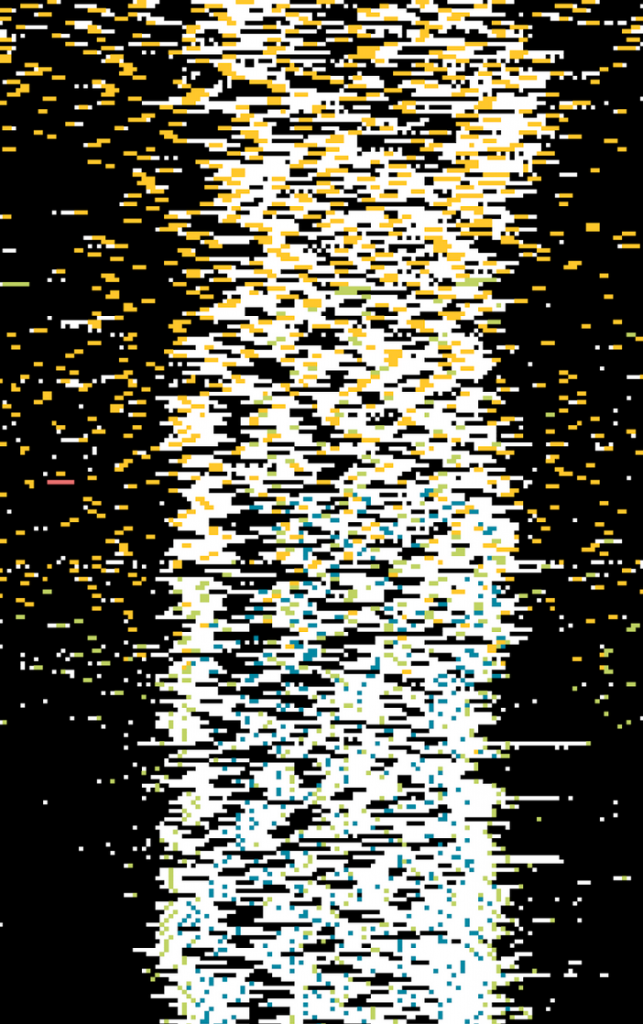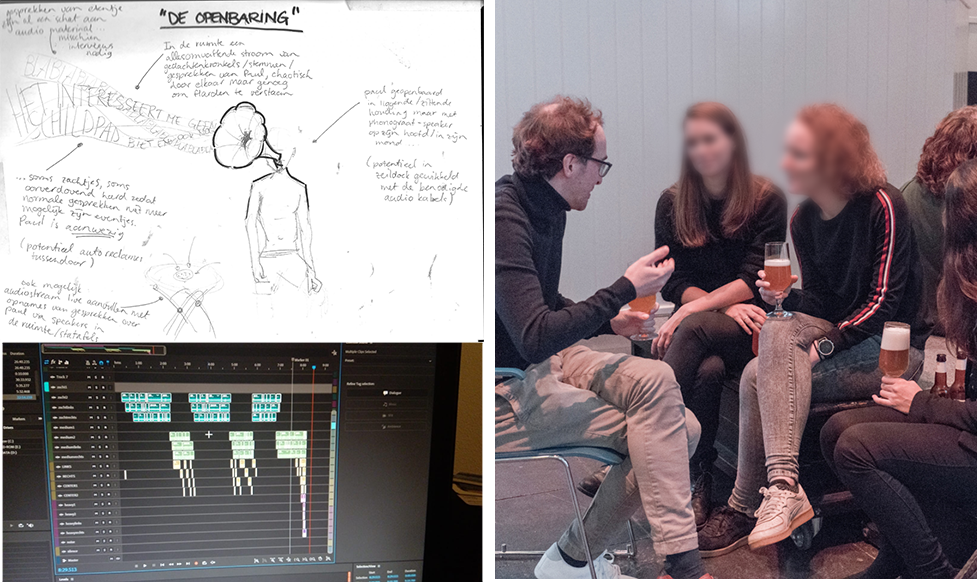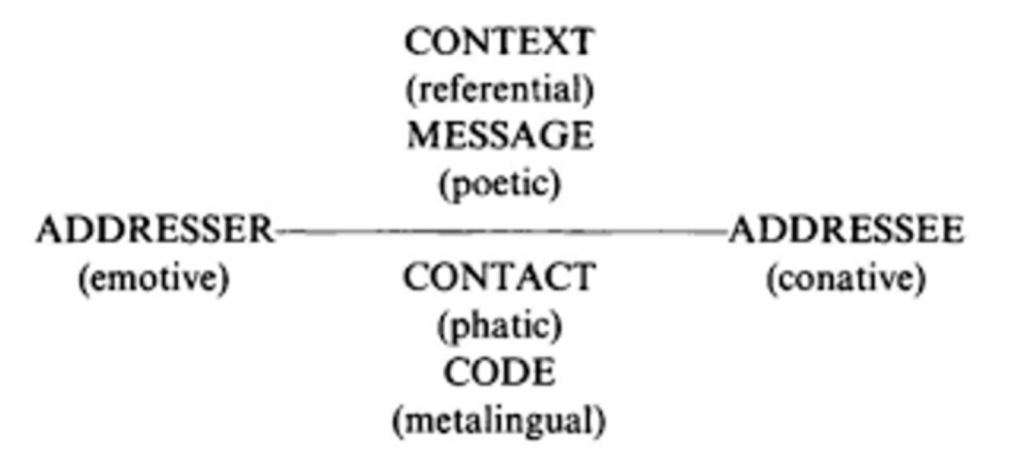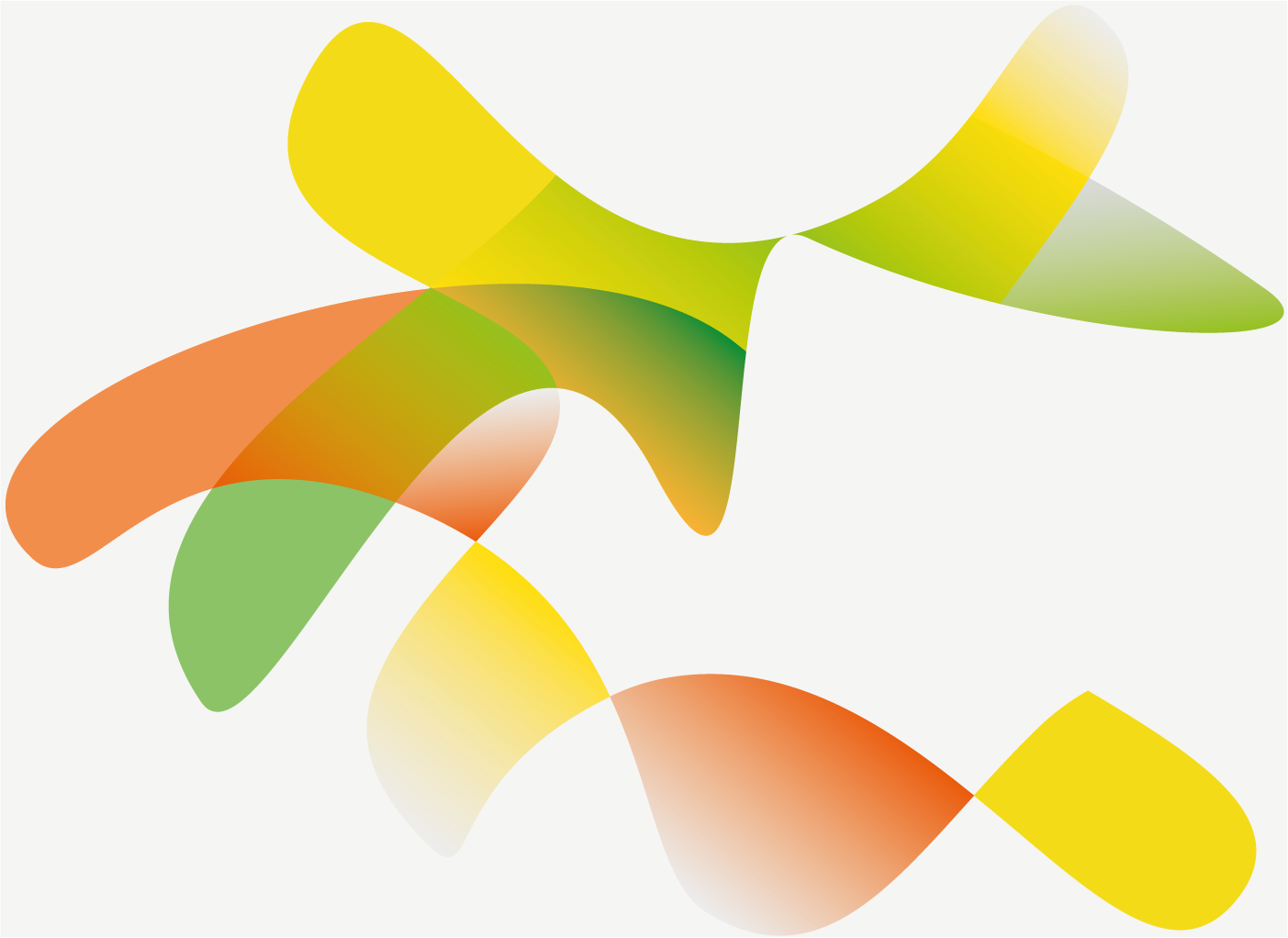
These pixels tell a story. They represent the eating and sleeping habits I collected of my newborn son. What started as a short experiment, ended up lasting a full year.
As an interaction designer and researcher, I worry myself with the design and use of digital technology in the field of Human-Computer Interaction (HCI). But sharing the image above with the rest of the world (or even close friends) makes me feel somewhat uncomfortable. Because why would you want to quantify your own baby, reducing something so personal to a piece of statistic? Along the way, answering this question gave me insights in how we experience and use informational content.
Collecting a year’s worth of data
Surprisingly, the value from this experiment doesn’t come from the actual data itself. Instead, the act of adding new data was a way for us to connect, share experiences and reflect on the day;
At the end of each day, when we went to bed, I would take my excel sheet and start talking about what happened that day, while filling in the relevant data. It became a moment of quiet contemplation in an otherwise rather stressful environment. In a way, this conversation was probably just as much about us and how we survived the day, rather than the particular sleeping habits of our baby. Furthermore, it helped us put rough days into perspective more easily by looking into the past; compared to previous periods, today might actually not have been as bad as we thought. Or in some cases, provide some comfort in the visual knowledge that most things seem to exist in temporary phases, and even the hardships eventually pass (after which new hardships inevitably present themselves…)

On a micro scale the data still offers enough information to get an idea of what was going on that day: was there a fever, did he wake up that night, were we traveling a lot, etc.

What certainly contributed to the success of this experiment was that the input data was immediately visualized in the same excel sheet; it turns out I am a simple sucker for pretty patterns and visualizations. Sometimes I caught myself feeling disappointed when new data would mess up emerging patterns or cause a visual misalignment, which is kind of funny in itself and shows the disconnect between the data itself and how we experience it; creating the visualization is more important than the meaning of the data itself.
So although the data and the information it holds might be interesting, the real value lies beyond this; it is not the data or even the information that really matters, but its ability to bring us together, comfort us, and possibly support our relationship in other ways.
I think this perspective is an interesting notion in a world that becomes over-saturated with technology and information. In fact, the very origin of the field of Human-Computer Interaction (HCI) lies in bringing computers and humans together in ways where interaction flows seamlessly, matching human capabilities and ergonomics, and allowing efficient flows of information*. Unsurprisingly, this has resulted in a focus on applications that have become helpful tools in our everyday lives. These applications tend to focus on bringing information to a user in an efficient and pleasurable way. But what would happen if we dare to forego the functional efficiency of exchanging information and instead focus on enhancing experiences?
Invoking presence at my father’s memorial
I found myself in a similar situation when I was confronted with the passing of my father, and organizing the memorial service. A service meant to mark the end of a life, but mainly a moment in time and a place to pay respects, share memories, grief and find comfort together. In the months prior to my father’s passing, I had gathered a lot of recorded audio of my father speaking about both the meaningful and mundane things in his life.
Traditionally, people take turns entering a center stage for their eulogies, talking about the deceased while a crowd solemnly listens in silence. While this may be a completely normal way to convey information in the form of personal stories, I wondered what would happen if the information would not be the center of attention, but the focus would instead be on the experiencing the person being talked about and invoking feelings of connectedness instead.
I felt it made sense using my audio recordings to give my father a more prominent ‘on-stage’ role during all this; Even though he was no longer there, I wanted people to feel close to him, and experience his presence. While relishing and sifting through all the audio recordings to find relevant audio fragments , I realized that the key to the experience was not finding the most informative parts of the conversation and the things that were said. Actually, it were the unique expressions in his way of speaking and his tone of voice that really hit home and made an impact. Funnily enough I realized it did not really matter much what he what saying, as long you could hear him.
To emphasize this thought, I used the recorded material to mix all the different pieces of conversation into a blended flurry of sound. While his voice remained immediately recognizable with all its unique perks, there were times where you could also still hear bits and pieces of the topic of the conversation. The voices would mostly remain gently on the background, almost as a whisper, but at times would swell in volume and chaos, taking everyone’s attention and drowning out all other conversations, filling the room with his presence.
Lexicon
Disconnect
I refer to this term when the intended (functional) purpose of a designed system does not match its perceived experience. For example: a lock on a door might be meant to prevent access, however in a specific context may also serve to invoke feelings of connectedness of being part of a select group who is allowed in.
Phatic Interaction
The phatic function of language as described by Jacobsen supports communication by a sense of mutual awareness. It is a recognition of eachother’s presence, like a channel being ‘open’ for communication or interaction. Therefore, phatic interaction involves experiencing feelings of connectedness towards each other.
Message
‘The message’ refers to the informational content of an exchange or interaction. Typical digital technologies and information systems focus heavily on supporting this type of interaction. It is most often used visually, as texts or images, but could also involve other sensory modalities.
Ditching the message
‘Ditching the message’ is a phrase I use to describe a shift in focus from delivering the message, towards phatic qualities of interaction.
Functional technology vs. Technology as a medium
Digital technology is traditionally designed with a functional focus in mind; they serve to solve a problem, or provide a critical service. In communication, they rely heavily on the message or content of informational exchange.
By ditching the message, the role of the digital technology becomes more indirect, focused on bringing people closer together. The designed products become a medium for solving a problem, rather than solving the problem by itself.

► Me conversing with others about my father near the audio installation.
The insights of these two experiments further cement my interest and belief that it is worthwhile to look beyond the functional way we’re used to conveying information to each other. Especially when designing social communication in sensitive settings, Letting the technology play a more modest role of being the medium, rather than the message itself, could lead to interesting applications. Moreover, it could be a helpful notion in the discussion about the role and application of digital technology in social contexts, and might broaden the perspective of technology being potentially more than a blunt tool in a delicate context.**
Beyond the informational message
Of course, communication itself has been a thoroughly researched subject throughout history. And obviously, I am not the first to notice aspects of communication beyond informational content. We know Aristotle noted that apart from logos (the rational content, or today’s information and data), also pathos and ethos plays a role in how we experience persuasion in communication**. Somewhat more recent, Jakobson* modeled the communication process into six functions of language. Other than the straight forward message that is exchanged between addresser and addressee, he identifies phatic, metalingual and referential factors. The phatic function supports feelings of awareness, contact and connectedness of one another. These match the latent qualities I discovered in my experiments; things like experiencing connectedness while working on a shared visualization, or the impact of experiencing someone’s presence through a voice, rather than what someone says.

So while the notion of looking to other aspects rather than the functional message isn’t a new thing in itself, using this perspective to create, or force a focus on other aspects rather than the functional message is something not often practiced in the field of human-computer interaction. Or at the very least, easily overlooked. There seem to be few vocal others who share this thought in my domain. Frank Vetere** is one to posit it adequately as follows:
“By asking ‘What phatic exchanges should awareness systems support’, instead of ‘What information should awareness systems convey?’ we reorient our design focus to seriously consider the extent to which awareness systems contribute to feelings of awareness and ongoing connectedness between people”.*
Going further, I am going ask myself this question, and invite others to answer it as well: What opportunities arise when designing information systems that focus on phatic qualities, rather than putting the message itself on the foreground?
Notes
** In a previous publication*, I proposed a method of dealing with a limited scope regarding how digital technology could be applied. I found that especially in participative design processes, digital technology is in danger of being regarded as a blunt tool, which can be especially harmful in delicate social contexts.
** This illustrates that even as far back as 350 BC (and arguably long before), there was considerate thought about the impact of language and communication. But since Aristoteles explored these notions in the context of the early rhetorics, it means that even the non-rational pathos and ethos constructs serve the greater purpose of delivering a powerful, persuasive message. Whereas I am more interested in putting these ‘secondary’ aspects in the spotlight, making them the main goal. Like invoking awareness, or providing comfort. Jakobson’s model provided me with a more appropriate framework.
** While Jakobson’s framework stems from the linguistic domain, it has been noted to be useful and applied in other domains as well, for example in a sociocultural context, or in the packaging design industry.
** Frank Vetere is a current-day researcher in the field of HCI and co-author of the book Awareness Systems, advances in Theory, Methodology and Design. In this book, he makes a point of phatic qualities of interaction not getting the attention they potentially deserve.
References
Duarte, Emanuel Felipe, and M. Cecília C. Baranauskas. “Revisiting the three HCI waves: A preliminary discussion on philosophy of science and research paradigms.” Proceedings of the 15th Brazilian Symposium on Human Factors in Computing Systems. 2016.
Jakobson, Roman. “Poetry of grammar and grammar of poetry.” Lingua 21 (1968): 597-609.
Jeurens, Jasper, Koen van Turnhout, and René Bakker. “Dispelling the Blunt Perception of Social Technology.” Extended Abstracts of the 2019 CHI Conference on Human Factors in Computing Systems. 2019.
Vetere, Frank, Jeremy Smith, and Martin Gibbs. “Phatic interactions: Being aware and feeling connected.” Awareness systems. Springer, London, 2009. 173-186.




